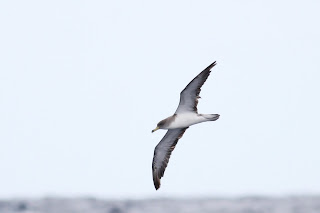We generally don't see any Black-capped Petrels until we get 25 or more miles out, so to see them on the shelf was exceptional. But we had exceptional conditions. The Gulf Stream had split and left a long tendril of pretty 85 degree water inshore. As we worked offshore, we eventually passed through a band of cooler water - about 83 degrees Fahrenheit - before the water started warming again and getting rough about three miles past the shelf break. We actually found more Black-capped Petrels - about 40 of them - shoreward of the break than we did offshore. There were also a few dozen Cory's Shearwaters (photo by Kate Sutherland),
a couple of Great Shearwaters, and several Audubon's. North wind is not very good for seeing Audubon's Shearwaters and tropical terns here, but we did have nice looks at an adult Sooty Tern and its begging youngster in an area of good seabird concentration. There were very few storm-petrels to be found near the shelf break. Perhaps there were more out in the deep, but it did not seem worth the beating to find out. I was hoping for a little action at the north side of the eddy but we saw few birds there except for a handful of shearwaters. There was a nice color change but it did not produce the hoped for phalaropes or Bridled Tern. We did find a nice little group of Atlantic Spotted Dolphins there (photo by Kate Sutherland), however,
and because it was in less than 30 fathoms, we had just an 18 mile ride back to the inlet. It was a great day to be out. We had a lot of folks on the boat who had not been out on a Hatteras trip before and our star seabird, the Black-capped Petrel, put on a great show. We ended up with almost 75 Black-caps for the day and some of the closest looks you ever get (photo by Kate Sutherland).
I would like to thank everyone from the Waterbird Society who came along and also those who helped arrange the trip but could not come. Our charter trip followed the 40th annual meeting of the group! Thanks also, of course, to Kate Sutherland for working the deck and making sure everything went as it should, all the while chumming, spotting birds, answering questions, and taking photos for this report!
Trip List September 25, 2016
Black-capped Petrel 74
Cory's Shearwater 47
Great Shearwater 2
Audubon's Shearwater 17
Wilson's Storm-Petrel 3
Red-necked Phalarope 2
Sooty Tern 2
jaeger sp. 1
Great Egret 32
Bottlenose Dolphin 2
Atlantic Spotted Dolphin 8
A shot showing the sea conditions and a Black-capped Petrel showing the diagnostic white rump patch easily visible at a distance.
A couple of Black-cappeds in the slick - we had up to at least eight following at a time!
A Black-capped coming in to the chumA dark individual - note the extensive dark in the underwing. This individual had some interesting dark spots on the some of the underwing feathers near the body (compare with the individual pictured below it). This bird also has a very dark face and smudgy neck collar, not white.
In contrast to the bird above, this individual is a lighter bird. Note how much white is in the underwing and also the white above the eye, nice black cap, and white collar.
The Atlantic Spotted Dolphins had a few young individuals with them too!
& the edge of the Gulf Stream on our way back in the afternoon - there was a nice temperature break and noticeable color change!











No comments:
Post a Comment